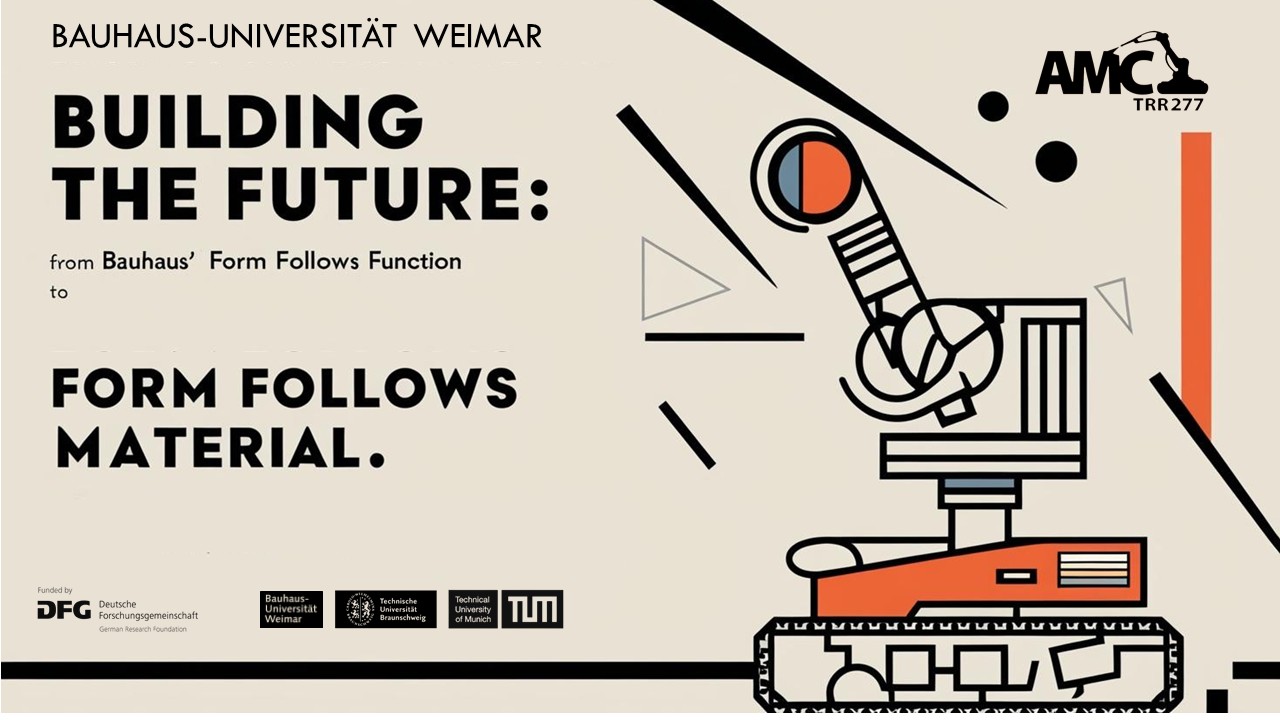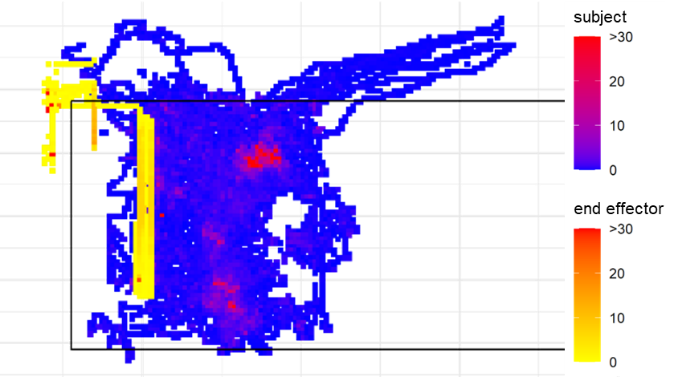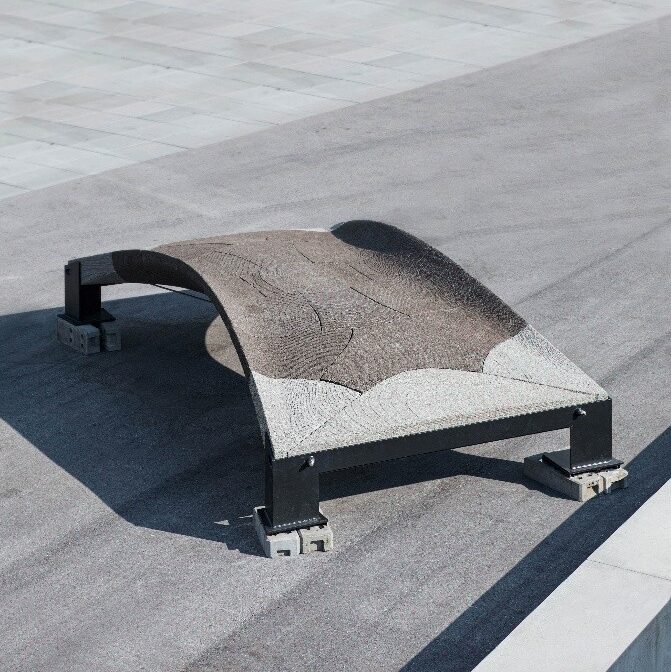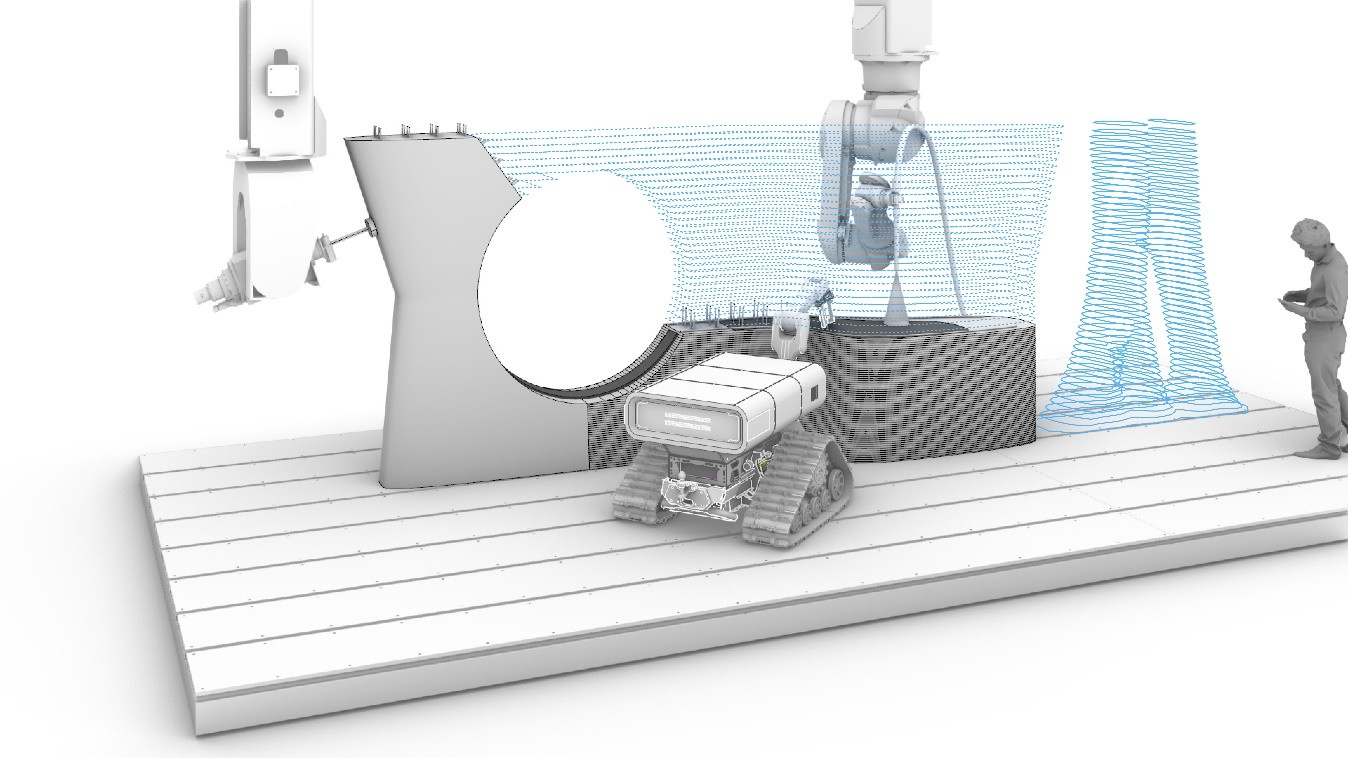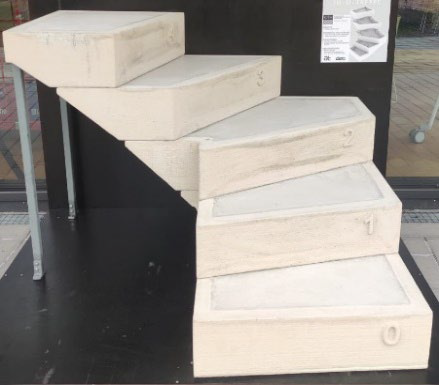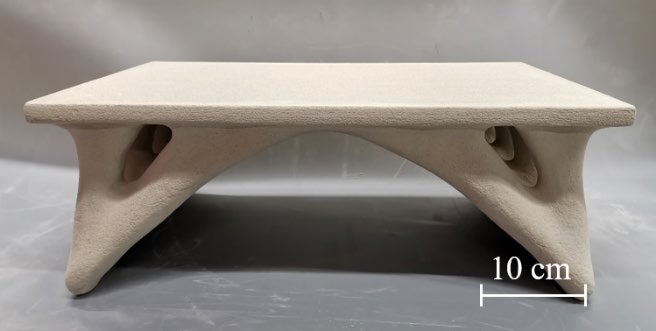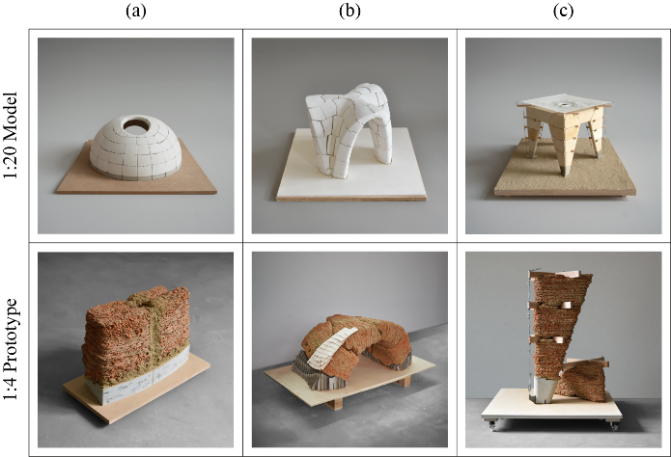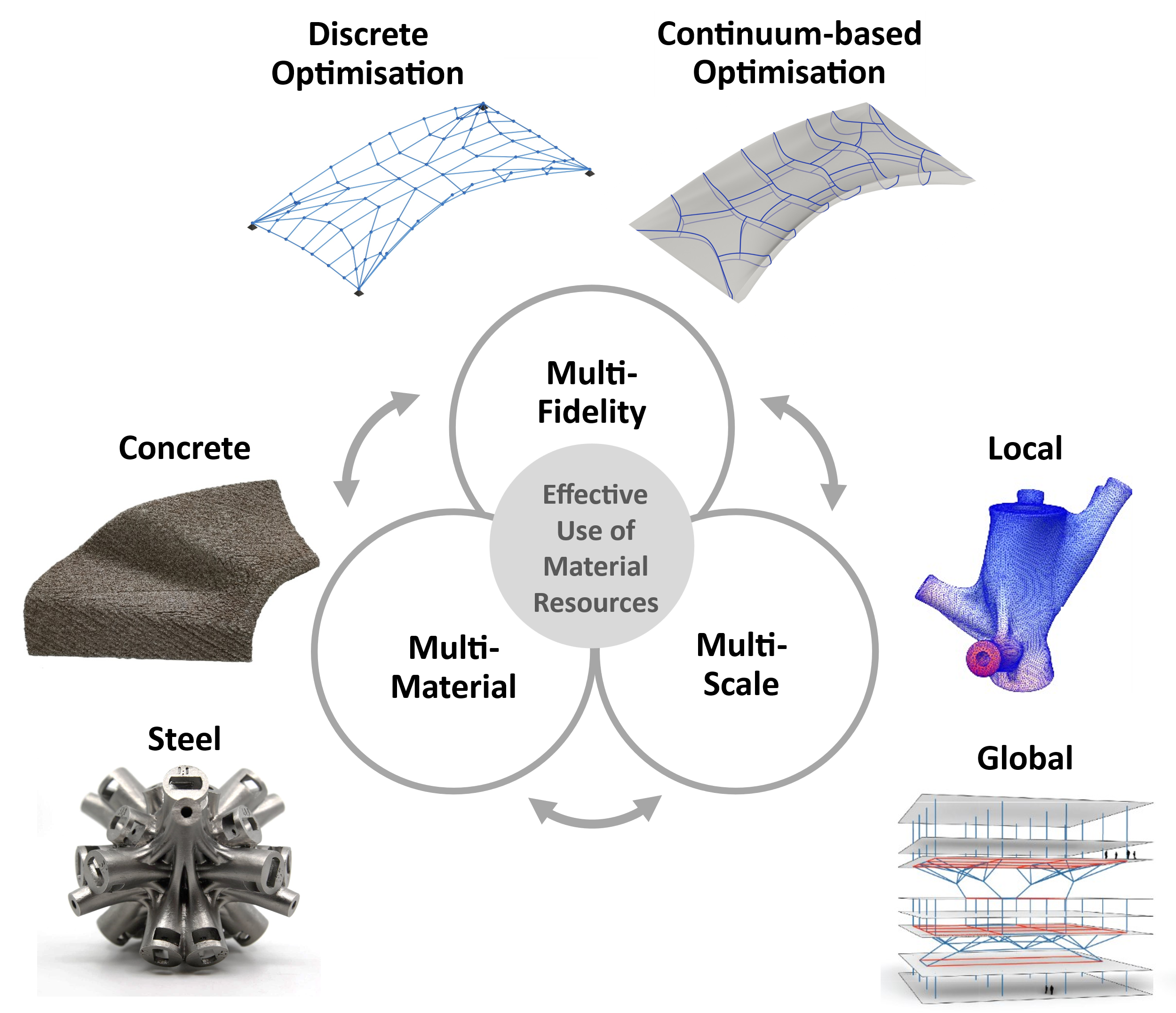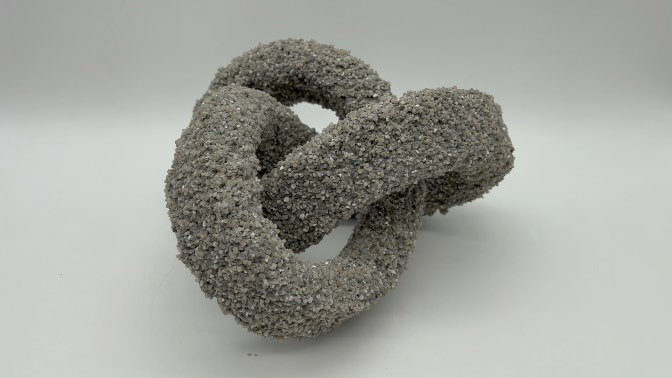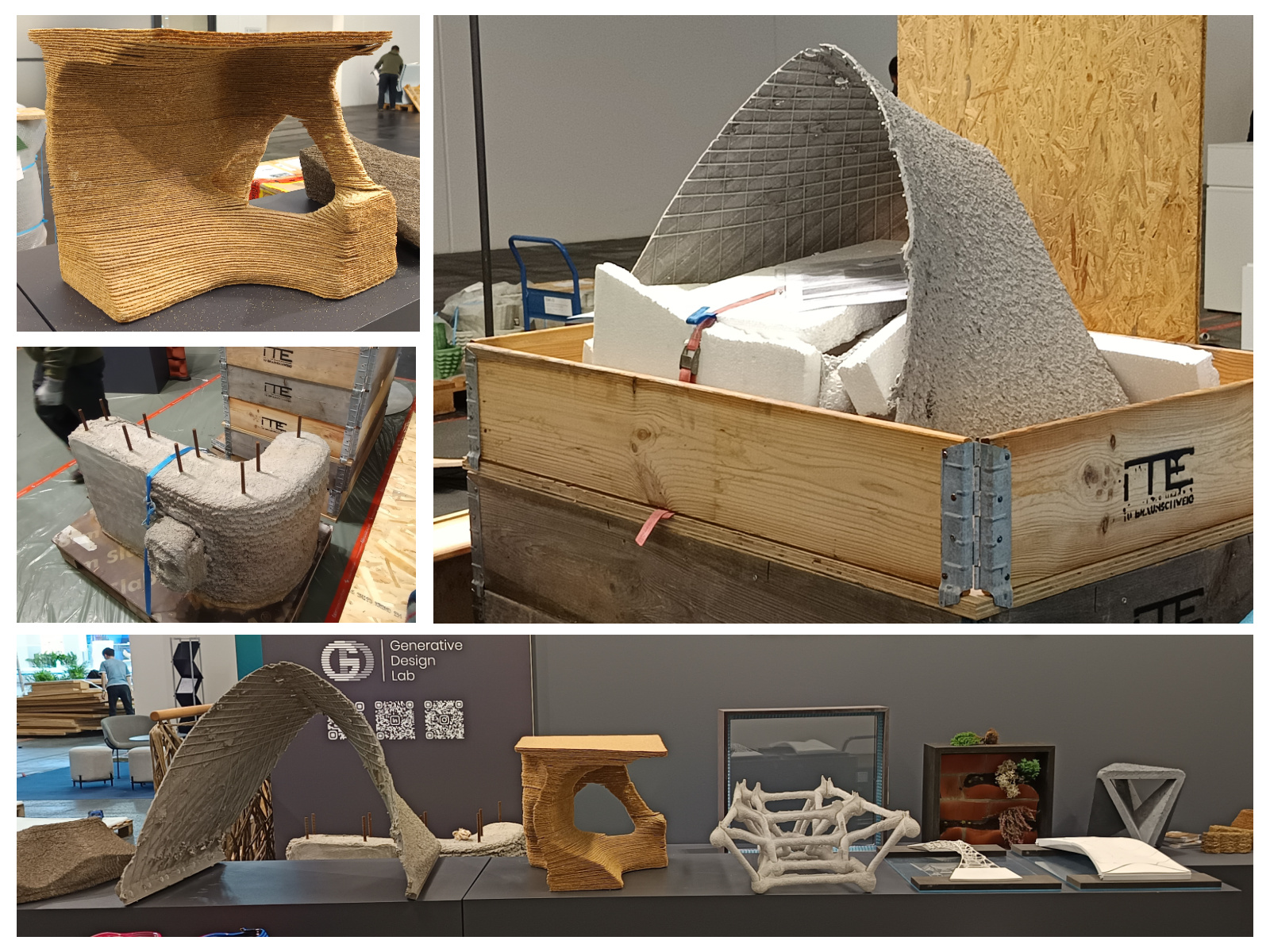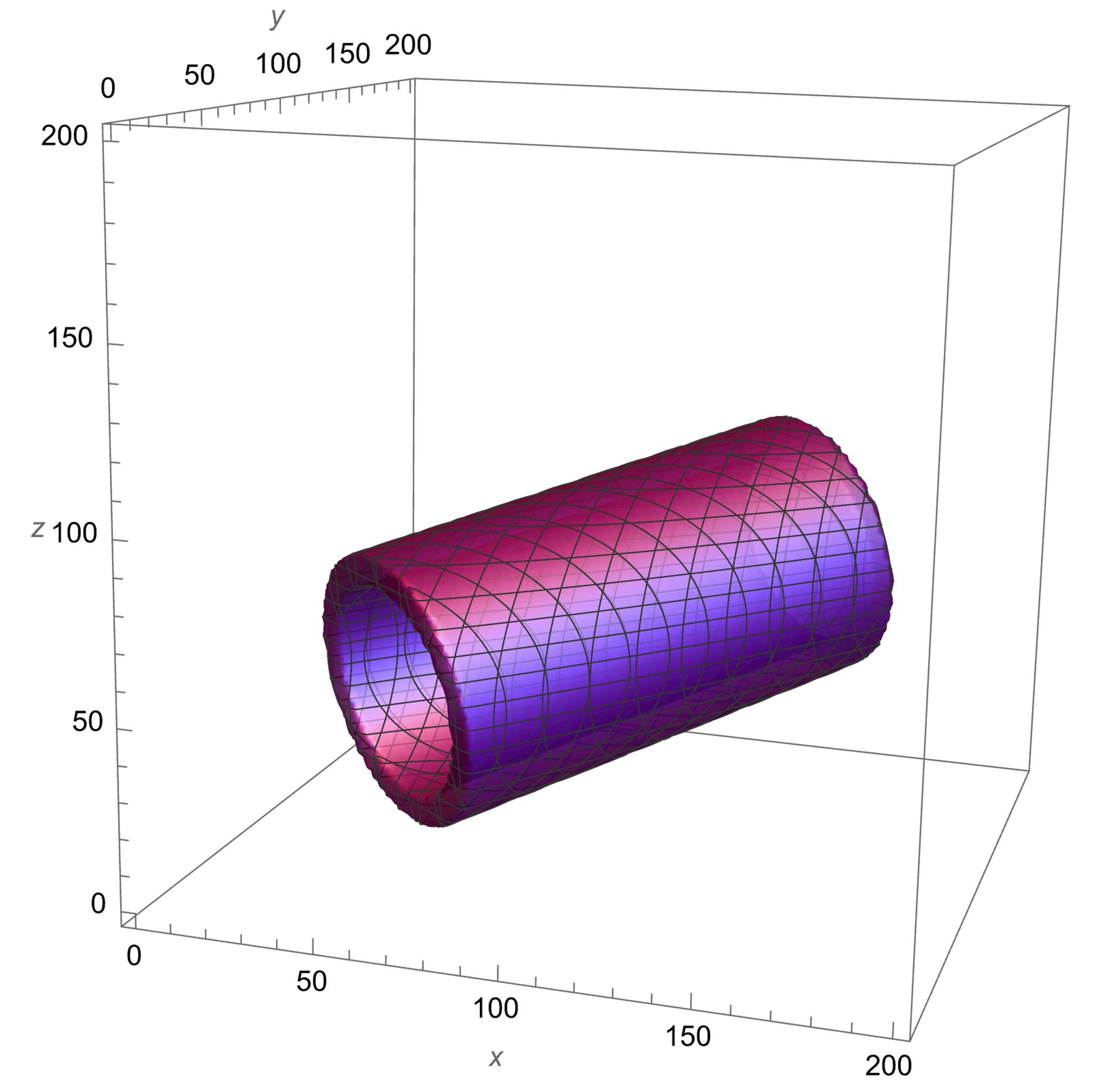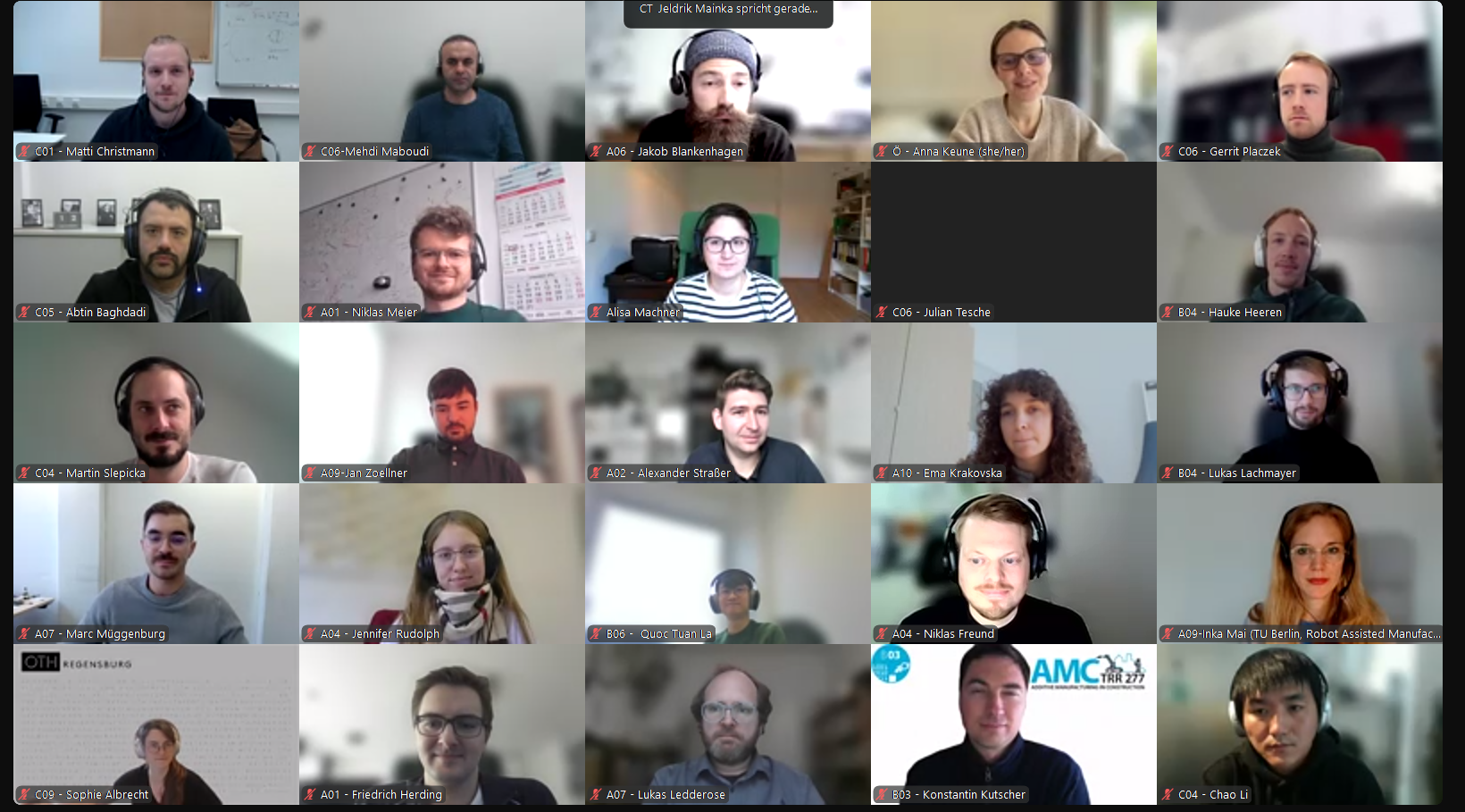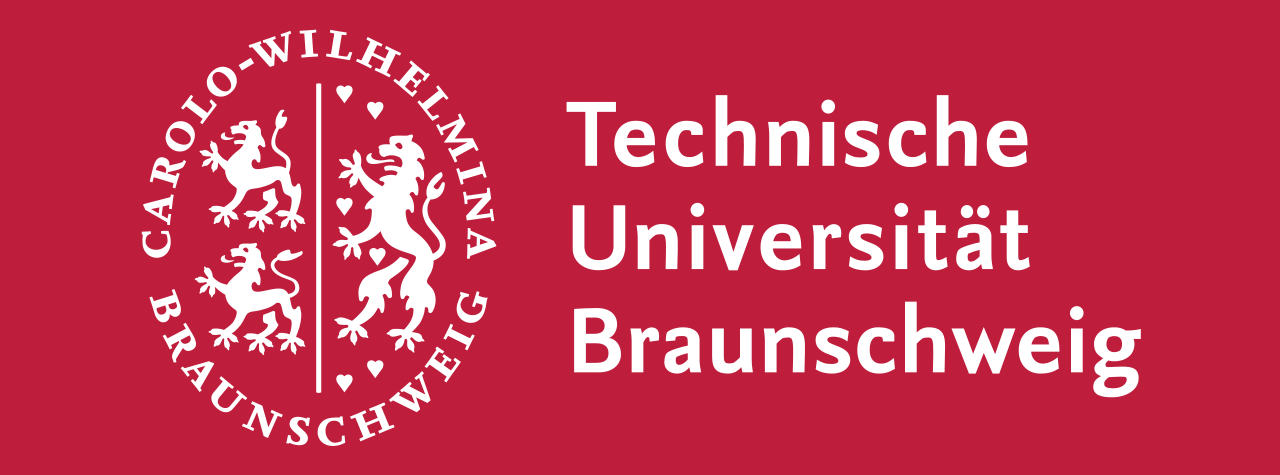News
Building the Future – Insights from the AMC – TRR 277 Symposium at Bauhaus-Universität Weimar
On March 31 and April 1, 2025, the AMC – TRR 277 Symposium Building the Future: From “Form Follows Function” to “Form Follows Material” took place at Bauhaus-Universität Weimar. More than 100 participants from research and industry gathered to discuss the latest advancements in digital design, robotic fabrication, and material-driven construction. The symposium was opened by Prof. Dr. Stefan Kollmannsberger, who organized the event in collaboration with the Collaborative Research Center AMC. This was followed by a welcome address from Prof. Peter Benz, President of Bauhaus-Universität Weimar. The keynote lectures featured leading experts, including Prof. Dr. Kathrin Dörfler and Prof. Dr. Harald Kloft, who introduced the Collaborative Research Center AMC, focusing on 3D printing in construction. Throughout the two-day event, …
Symposium: Building the Future
The AMC Symposium: Building the Future explores the transition from Bauhaus’ guiding principle “Form Follows Function” to the contemporary leading theme “Form Follows Material.” This two-day event brings together leading researchers and industry experts to discuss the future of construction, digital structures, and sustainable materials. March 31 – April 1, 2025 Bauhaus-Universität Weimar, Maurice-Halbwachs-Auditorium (Steubenstraße 6, Haus F, Weimar) Key Topics: Additive Manufacturing in Construction Digital Structures and Computational Design Sustainable Building Materials Bauhaus Principles in the Digital Age Lectures from Caitlin Mueller MIT, Jan Willmann Bauhaus-Universität Weimar, Bauhaus Dessau, MFPA, Brüninghoff Group, SOPHISTIK AG, and more! March, 31: “Form Follows Material” – Insights into additive manufacturing, digital structures, and resource-efficient construction.April, 1: “What We Can Learn from Bauhaus” …
Research Summary Report of C06
Category: Research Summary Report
Integration of Additive Manufacturing in the Construction Process [12.03.2025] M. Sc. Jan Thormählen Researcher, jan.thormaehlen@tu-braunschweig.de M. Sc. Gerrit Placzek Researcher, g.placzek@tu-braunschweig.de Prof. Dr.-Ing. Patrick Schwerdtner Project Leader, patrick.schwerdtner@tu-braunschweig.de Technische Universität Braunschweig (TU BS), Institut für Bauwirtschaft und Baubetrieb/Institute for Construction Engineering and Management The integration of additive manufacturing into construction requires an interdisciplinary approach. The different competences of the team – digital fabrication in architecture (Hack), geodesy and photogrammetry (Gerke) and construction management (Schwerdtner) – lead to research from diverse perspectives on the various scalar levels of construction to be viewed holistically: component, building and industry scale. Within subproject C06, the goal of …
Research Summary Report of A07
Category: Research Summary Report
Wire and Arc Additive Manufacturing (WAAM) of Complex Individualized Steel Components [10.02.2025] Martin Gabriel Altobelli Student Assistant, martin-gabriel.altobelli@mb.tu-chemnitz.de Dr. Kevin Hoefer Researcher, kevin.hoefer@mb.tu-chemnitz.de Prof. Dr.-Ing. Jonas Hensel Project Leader, jonas.hensel@mb.tu-chemnitz.de Technische Universität Chemnitz (TUC), Institute for Joining and Assembly Technology A07 focusses on advancing WAAM technology for large structures and on-site applications by addressing material interactions and incorporating manufacturing constraints through a Holistic Design Framework (HDF). A “Learning-by-Printing” approach will enhance the process via online decision-making to mitigate geometric deviations, process irregularities, and heat accumulation. Additionally, research on buckling behaviour will investigate geometric imperfections, load-deformation, load-bearing cross sections, and ductility. The development …
Research Summary Report of A10
Category: Research Summary Report
Earth Additive Manufacturing (EAM) – Material and Process Combinations for AM with Earth-based Materials [06.02.2025] M. Sc. Hannes Eichler Researcher, hannes.eichler@tu-braunschweig.de M. Sc. Diana Zavaleta Researcher, diana.zavaleta@tu-braunschweig.de Prof. Dr. Harald Kloft Project Leader, h.kloft@tu-braunschweig.de Technische Universität Braunschweig (TUBS), Institute of Structural Design (ITE) The main goal of the A10 project is to develop and investigate two innovative Earth Additive Manufacturing (EAM) techniques: Sprayed Earth Additive Manufacturing (SEAM), a deposition-based process (PL Kloft), and Intrusion Earth Additive Manufacturing (IEAM), a particle-bed-based process (PL Dörfler). The study focuses on characterizing …
Research Summary Report of C02
Category: Research Summary Report
3D Structural Puzzle – Numerical Multi Scale Shape and Topology Optimisation Methods to Additively Manufacture Optimal Structures from Optimised Pieces [06.02.2025] M. Sc. Christiane Richter Researcher, christiane.richter@tum.de Prof. Dr. Pierluigi D’Acunto Project Leader, pierluigi.dacunto@tum.de Technische Universität München (TUM), Professorship of Structural Design (SD) Current building practices often adopt a sequential design approach, where architectural, structural, and fabrication aspects are addressed independently, resulting in excessive material consumption. The CO2 project aims to establish a Holistic Design Framework (HDF) integrating the above-mentioned aspects. Within this framework, additive manufacturing facilitates structural optimization by enabling the production of bespoke geometries for an effective use …
Research Summary Report of C01
Category: Research Summary Report
Bridging Scales – From Geometric Part Details to Construction Elements [06.02.2025] M. Sc. Matti Christmann Researcher, matti.christmann@uni-weimar.de Prof. Dr.-Ing. Stefan Kollmannsberger Project Leader, stefan.kollmannsberger@uni-weimar.de Bauhaus-Universität Weimar (BUW), Professur Data Engineering im Bauwesen (DEiB) Digital models for Additive Manufacturing (AM) must consider many different geometric scales. The scales range from micrometers up to tens of meters for metal- or concrete-based processes and mutually influence each other. Project C01 aims to develop consistent geometric and computational descriptions for the relevant AM products on all these scales. As-built structures naturally deviate from as-designed structures in geometry, topology, and material properties especially in AM. The consequences of such deviations upon the structural behavior …
Research Summary Report of B04
Category: Research Summary Report
Process Control and Adaptive Path Planning for Additive Manufacturing Processes Based on Industrial Robots with an Extended Degree of Freedom [06.02.2025] Prof. Dr.-Ing. Annika Raatz Project Leader, raatz@match.uni-hannover.de M. Sc. Lukas Lachmayer Researcher, lachmayer@match.uni-hannover.de M. Sc. Hauke Heeren Researcher, heeren@match.uni-hannover.de Leibniz Universität Hannover (LUH), Institute of Assembly Technology and Robotics The research of project B04 is dedicated to extending the current state-of-the-art path planning and process control algorithms for concrete-based additive manufacturing. The objective is to enable reproducible production of multi-material components utilizing mobile robot systems in motion, known as …
Research Summary Report of A04
Category: Research Summary Report
Integrated Additive Manufacturing Processes for Reinforced Shotcrete 3D Printing (SC3DP) Elements with Precise Surface Quality [29.01.2025] M. Sc. Robin Dörrie Researcher, r.doerrie@tu-braunschweig.de Technische Universität Braunschweig(TU BS), ITE Institute of Structural Design The project aims to fundamentally understand the Shotcrete 3D Printing (SC3DP) technology to manufacture sustainable, multi-objective optimised, reinforced concrete components with precise surface quality and improved building physics via functional integration. It seeks to minimise the carbon footprint of 3D printed structures by exploring various material strategies, such as reducing cement content by increasing the aggregate size or replacing cement with a different binder and design methods to optimise the usage of concrete in order to decrease the …
Research Summary Report of A03
Category: Research Summary Report
Extrusion of Near-Nozzle Mixed Concrete – Individually Graded in Density and in Rate of 3D Fibre Reinforcement [22.01.2025] M. Eng. Benedikt Grimm Researcher, benedikt.grimm@tum.de M. Sc. Christian Maximilian Hechtl Researcher, m.hechtl@tum.de Dr.-Ing. Thomas Kränkel Project leader, thomas.kraenkel@tum.de Prof. Dr.-Ing. Christoph Gehlen Project leader, gehlen@tum.de Technische Universität München(TUM), Chair of Material Science and Testing The goal of A03 is to establish a concrete extrusion process using a near nozzle mixing (NNM) approach to enable the gradual variation of material properties during printing (gradation). This approach allows for the creation of multifunctional components, such as structures …
Research Summary Report of C09
Category: Research Summary Report
Environmental Life Cycle Assessment – Determination of Ecological Sustainability Potentials by AMC [11.12.2024] M. Eng. Sophie Viktoria Albrecht Researcher, Sophie.albrecht@oth-regensburg.de Prof. Charlotte Thiel Project leader, charlotte.thiel@oth-regensburg.de Ostbayerische Technische Hochschule Regensburg (OTH), Construction Materials C09 aims to enhance the ecological sustainability of Additive Manufacturing in Construction (AMC) by quantifying and optimizing its environmental benefits through comprehensive Life Cycle Assessments (E-LCA) from cradle to cradle. This involves developing transparent Product Environmental Footprint Category Rules (PEFCR), identifying impactful reduction measures, and integrating circular design strategies to create durable, efficient, and reusable components. By incorporating these findings into Fabrication Information Modelling (FIM), C09 enables early-stage, sustainability-focused decision-making, fostering material-efficient, low-impact construction practices and reducing the environmental footprint of the building …
Research Summary Report of B06
Category: Research Summary Report
Material Modelling and Simulation of Deposition AM Processes on the Part Scale [11.12.2024] M. Sc. Quoc Tuan La Researcher, quoc-tuan.la@tu-braunschweig.de Prof. Dr.-Ing. Ralf Jänicke Project leader, r.janicke@tu-braunschweig.de Technische Universität Braunschweig, Institute of Applied Mechanics Prof. Dr.-Ing. habil. Stefan Kollmannsberger Project leader, stefan.kollmannsberger@uni-weimar.de Bauhaus-Universität Weimar, Professorship of Data Engineering in Civil Engineering The main goal of the project is to simulate the deposition process of additive manufacturing for complex geometries. The simulation focuses on Shotcrete 3D Printing (SC3DP) and includes identifying and calibrating a thixotropic material model. Additionally, Variationally consistent Computational Homogenization is employed to minimize computational costs. Summary Shotcrete 3D Printing (SC3DP) is a soft material that hardens over time through structure formation …
Research Summary Report of A01
Category: Research Summary Report
Particle-Bed 3D Printing by Selective Cement Activation (SCA) – Sustainability, process enhancement and material models [04.12.2024] M. Sc. Friedrich Herding Researcher, friedrich.herding@tum.de Prof. Dr.-Ing. Dirk Lowke Project leader, lowke@tum.de TU Munich (TUM), Chair of Binder Jetting Technology Our main research objective is the fundamental understanding of the material-process interactions in particle bed 3D printing (PB3DP) by Selective Cement Activation (SCA). This will allow for the manufacturing of concrete elements with high mechanical strength and dimensional accuracy. Besides we also investigate different ways of reinforcement integration, which is crucial for the manufacturing of load-bearing building components. Summary Selective Cement Activation (SCA) is a particle bed 3D printing technique that offers the possibility to precisely manufacture free-form …
Research Summary Report of A10
Category: Research Summary Report
Earth Additive Manufacturing (EAM) – Material and Process Combinations for AM with Earth-based Materials [29.11.2024] M. A. Ema Krakovská Researcher, ema.krakovska@tum.de Prof. Dr. Kathrin Dörfler Project leader, doerfler@tum.de all: TU Munich (TUM), Professorship of Digital Fabrication The main research objective of A10 is the conception and investigation of two novel Earth Additive Manufacturing (EAM) processes, their material-process interactions, and their evaluation in large-scale architectural applications. Focusing on the characterisation of earth-based material mixtures (PL Machner), the project investigates a) Sprayed Earth Additive Manufacturing (SEAM) as a deposition-based process (PL Kloft) and b) Intrusion Earth Additive Manufacturing (IEAM) as a particle-bed-based process (PL Dörfler). The research aims to assess earth-based materials for these processes with a …
Research Summary Report of C02
Category: Research Summary Report
3D Structural Puzzle – Numerical Multi Scale Shape and Topology Optimisation Methods to Additively Manufacture Optimal Structures from Optimised Pieces [27.11.2024] M. Sc. Philipp Jakobs Researcher, philipp.jakobs@tum.de Prof. Dr.-Ing. Roland Wüchner Project leader, wuechner@tum.de all: TU Munich (TUM), Chair of Structural Analysis Current building practices often adopt a sequential design approach, where architectural, structural, and fabrication aspects are addressed independently, resulting in excessive material consumption. The CO2 project aims to establish a Holistic Design Framework (HDF) integrating the above-mentioned aspects. Within this framework, additive manufacturing facilitates structural optimisation by enabling the production of bespoke geometries for an effective use of material resources. Departing from the conventional sequential approach, the HDF concurrently integrates low-fidelity Discrete Optimisation Approaches …
Research Summary Report of A02
Category: Research Summary Report
Particle-Bed 3D Printing by Selective Cement Paste Intrusion (SPI) – Particle Surface Functionalisation, Particle Synthesis and Integration of WAAM Reinforcement [20.11.2024] M. Sc. Alexander Straßer Researcher, alexander.strasser@tum.de Dr.-Ing. Thomas Kränkel Researcher, thomas.kraenkel@tum.de Prof. Dr.-Ing. Christoph Gehlen Project leader, gehlen@tum.de all: TU Munich (TUM), Chair of Materials Science and Testing The goal of A02 is to implement reinforcement by Wire and Arc Additive Manufacturing (WAAM) in concrete elements produced by Selective Paste Intrusion (SPI), see Figure 1. The SPI and combined SPI + WAAM process will also be further investigated with a focus on ecological improvements. Both individual processes will first be examined separately. To achieve these goals, the SPI process will include optimization …
Discover the Future of Construction: AMC at formnext, Frankfurt
Category: Press release
Frankfurt, November 2024 – From November 20–22, 2024, the Collaborative Research Center TRR 277 “Additive Manufacturing in Construction” (AMC) will present its cutting-edge research and innovations at formnext / Built Environment Additive Manufacturing BE-AM Exhibition 2024 📍 Location: Hall 11, Booth 47-49 The AMC team will feature interactive exhibits that highlight advancements in additive manufacturing technologies for construction. Visitors are encouraged to join us for engaging discussions on how digital and additive manufacturing is transforming construction processes and materials. Keynote Highlight: Norman Hack (TU Braunschweig) Don’t miss the keynote by Norman Hack, a leading expert in digital and additive construction and Professor at TU Braunschweig. His talk, titled “Advances in Additive Manufacturing for Construction,” will explore groundbreaking projects developed within …
Research Summary Report of C05
Category: Research Summary Report
Jointing Principles for Combination of Concrete Elements Produced by Different Additive Manufacturing Processes [14.11.2024] Prof. Dr.-Ing. Harald Kloft Project leader, h.kloft@tu-braunschweig.de Dr.-Ing. Abtin Baghdadi Researcher, a.baghdadi@tu-braunschweig.de Dipl.-Ing. Lukas Ledderose Researcher, l.ledderose@tu-braunschweig.de TU Braunschweig, Institute of Structural Design (ITE) Prof. Dr.-Ing. Martin Empelmann Project leader, m.empelmann@ibmb.tu-braunschweig.de TU Braunschweig, Institute of Building Materials, Concrete Construction and Fire Safety (iBMB) In the second phase of the C05 project, research will focus on advancing connection methods and robotic manufacturing techniques, such as waterjet cutting and stamping in green-state concrete, while incorporating post-tensioning and steel connectors for higher load-bearing capacity and easier assemblage of AM concrete segments. The project will explore new design …
Research Summary Report of B03
Category: Research Summary Report
Modelling and Simulation of Shotcrete 3D Printing (SC3DP) Based on a Massively Parallel Multi-Phase, Multi-Component Coupled LBM-DEM Approach [14.11.2024] Prof. Dr. rer. nat. M. Geier Project leader, geier@irmb.tu-bs.de Dr.-Ing. K. Kutscher Researcher, kutscher@irmb.tu-bs.de Prof. Dr.-Ing. habil. M. Krafczyk Project leader, kraft@irmb.tu-bs.de Dr.-Ing. H. Alihussein Researcher, hussein@irmb.tu-bs.de TU Braunschweig, Institute for Computational Modeling in Civil Engineering, IRMB (Institut für rechnergestützte Modellierung im Bauingenieurwesen) The project is currently concerned with the simulation of a moving nozzle for the injection process using I3DCP. We are particularly interested in the influence of the movement of the nozzle on the printed strand. Summary The I3DCP is a three-phase problem where the …
Press release: Strong Network for Research Progress
Category: Press release
Braunschweig/Munich, November 2024 – AMC Meeting Focuses on Publication Strategies and Discusses Sustainable 3D Printing Applications in Construction On November 11 and 12, 2024, over 70 scientists from the Collaborative Research Center AMC TRR 277 gathered online for the quarterly Cross-Project Workshop to present recent project developments, publication strategies, and networking plans for the second funding period. The meeting offered an important platform for aligning projects and laying the groundwork for continued collaboration. The core focus of AMC TRR 277 is advancing 3D printing as a key technology for a future-oriented construction industry. The research aims to unlock the vast potential of this technology for construction and to develop practical applications that are feasible in the long term. This …

